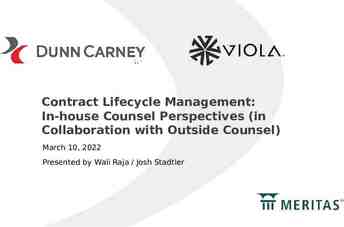Counseling Children/Adolescents in Blended Families
22 Slides612.00 KB
Counseling Children/Adolescents in Blended Families (Stepfamilies) Nancy Salgado-Martinez Donna Elizabeth Williams University of North Florida Summer, 2005
What is a blended family or stepfamily? In a blended or stepfamily, one or both adults: have been married before have children from previous marriage(s) have lost a spouse through divorce or death
FAMILY IMPACT Today, at least 1/3 of all children in the U.S. are expected to live in a stepfamily before they reach age 18. One of three Americans is now a stepparent, stepchild, stepsibling, or some other member of a stepfamily.
Children of Divorce One million American children experience divorce every year. 65% of divorced children had no contact with their fathers in the first year after divorce. 35% still had no contact after five years.
Divorced children Have the deepest feelings of fear, anger, and rejection for any childhood group. Have significantly higher rates of depression, low self-esteem, drug abuse, alcohol abuse, and juvenile delinquency. Are three times as likely to receive professional help.
Disruptive Behavior Disorders Boys and girls can get swept up in a sudden whirlwind of anger, grief, newfound fears, competition, and detachment disorders. For Example: Anxiety Disorders Mood & Depressive Disorders Oppositional Defiant Disorder Separation Anxiety Disorders
Impact on Children Suicide rates for teenage males increased 57% from 1966 to 2000. The single best predictor of teen suicide was parental divorce and living in a single-parent household. Early sexual behavior was more frequent among children living in stepfamilies.
Summary of the Data Children in blended families 1. Are at much greater risk of being left behind both scholastically and emotionally than are children from intact families. 2. Experience higher rates of stress, depression, absenteeism, low selfesteem, negative peer influences, and apathy about academic growth.
Blended Families: Handle With Care School Counselors Should: Act as the child’s advocate, ensuring that parents and teachers are understanding of the child’s need for help.
Impact on Children at School Children in Blended Families: Drop out of school is twice the rate of children from intact families Are twice as likely to be suspended or expelled from school Consistently show lower test scores lower grades more placement remedial classes
COUNSELING APPROACH Small-Group Counseling Goals: To identify and clarify students’ feelings and behaviors concerning their parents’ remarriage. 1. To help students develop a realistic picture of their situation and make effective decisions. 2. To give students an opportunity to learn new communication and coping skills. 3. To help students discover the positive aspects of their unique situation.
“But I Feel Like My Whole World Just Fell Apart!” It’s normal to feel lots of different things, including anger, fear, and sadness. There are ways to deal with the feelings you have. But never take your feelings out on another person. Telling someone how you feel can also help. Talking is much better than keeping your feelings to yourself or acting all grouchy and irritable.
Getting used to Stepparents You might wonder about rules and whether you really have to listen to your stepparent even though he or she is not your real mom or dad. A stepparent is another adult who’s looking out for you, so it’s best to give him or her the same level of respect you give your own parent, coach, or teacher at school.
What if you can’t get along? OK, so you’ve given it some time. You’ve tried to like your stepparent but you just don’t get along! You can’t stop wishing that things were the way they were before. But ask yourself, Is it really her/him you don’t like?
One Big, Happy Family It’s important to understand that when you get along with your stepparent, it does not mean you care less for the parent you may no longer live with most of the time. The more good you can find in your stepparent and your situation, the closer you’ll become.
What should I do if I get angry? Talk to a friend you can trust Count to 10 Get or give a hug Stamp your feet Beat up a pillow because the pillow can’t get hurt Draw a picture of your anger Play a video game Sing along with the stereo Take a bike ride
Collaboration with Teachers Convey to teachers that a child in a blended family undergoes a period of adjustment. Teachers can incorporate lessons that enhance the students’ emotional, personal and social acceptance of his/her unique situation. In Classroom Guidance Lessons incorporate fictional stories or books to promote emotional well-being for students, e.g. Second Chances, by Waller Stein, J. & Blakeslee, S.
Collaboration with Parents Counselors should keep in mind the sensitivity and privacy of this topic. Stepparents also have rights under the Family Educational Rights and Privacy Act (FERPA). Counselors should welcome stepparents to discuss their stepchild’s academic and behavioral development.
When to seek professional help? When a child is consistently having problems, such as anger, sadness, and withdrawal. When symptoms get worse rather than better over time. When there is a sudden or dramatic change. If a parent feel they can’t cope.
Related Web Sites SecondWivesClub.com - Sanctuary, support, solutions, & sanity for second wives & step moms world wide! The Greatest Parenting Secret In History - Raising Kids With Life Skills makes both parenting and growing up easier to do - This is a great resource for parents! Life in a Blender is a volunteer organization comprised of a group of dedicated Biological Moms and Step Moms of blended families. The 'Blender Moms' are dedicated to sharing their experiences within their blended family in an effort to enlighten, encourage, and educate fellow members. Kids and Teens at StepMomGroup.com is a complete guide to kids and teens for step moms with articles, tips, tricks and advice.
References Research and Statistics Affecting Blended Families American Association of Counselors website: www.acc.net 9/19/04) www.stepfamily.org www.blendedfamilily.com Berk, L. E. (2003). Development through the Lifespan, Third Edition. Boston MA Pearson Education Inc. Bray, J.H. (1999) Developmental Issues in Stepfamilies Hetherington (Ed). Hetherington, E.M & Clingempeel, W.G. (1992). Coping with Marital Transitions: A family perspective. Hetherington E.M. (1999). Adolescent siblings in stepfamilies: Family adjustments. Monographs of the Society for Research in Child Development, 64 Serial No. 259
And now Classroom Activity



























